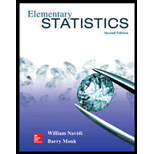
Concept explainers
(a)
>The least squares regression line for the given data set.
(a)
>Answer to Problem 24E
Explanation of Solution
Given information:
The following table represents the ages of the last
U.S. presidents and their wives on the first day of their presidencies:
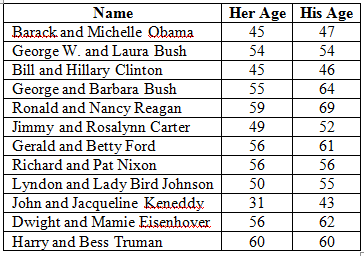
Concepts Used:
The equation for least-square regression line:
Where
The
Where,
The standard deviations are given by:
Calculation:
The mean of
The mean of
The data can be represented in tabular form as:
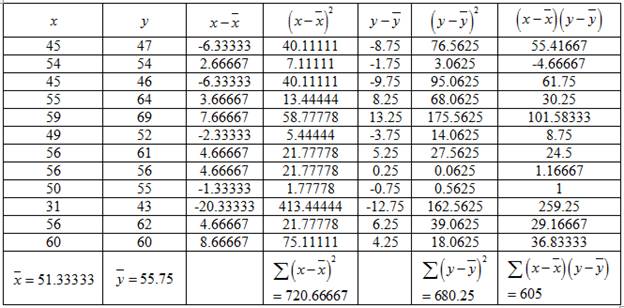
Hence, the standard deviation is given by:
And,
Consider,
Putting the values in the formula,
Putting the values to obtain
Putting the values to obtain
Hence, the least-square regression line is given by:
Therefore, the least squares regression line for the given data set is
(b)
>The coefficient of determination.
(b)
>Answer to Problem 24E
Explanation of Solution
Given information:
Same as part
Calculation:
From part
The coefficient of determination is given by:

Where
Putting the values to obtain Coefficient of Determination,
Therefore, the Coefficient of Determination is
(c)
>A
(c)
>Answer to Problem 24E
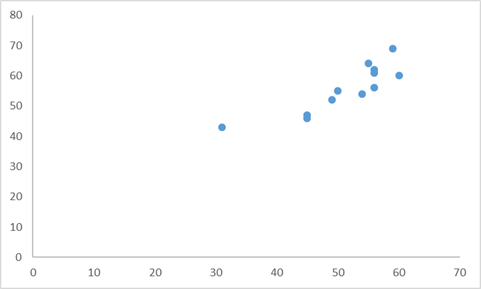
Explanation of Solution
Given information:
Same as part
Calculation:
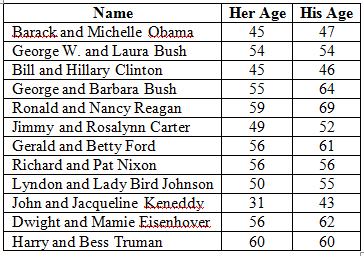
Consider age of the president as
The points representing the data would be given by:
Plotting the points to make a scatter plot:
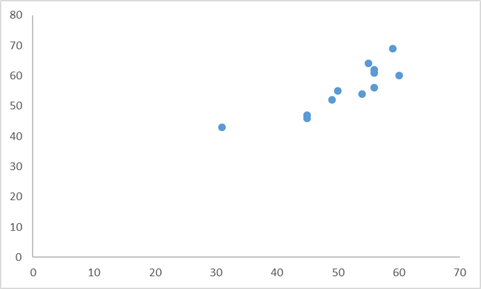
(d)
>The outlier points.
(d)
>Answer to Problem 24E
Explanation of Solution
Given information:
Same as part
Calculation:
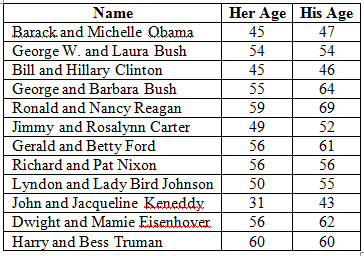
From the given table, it can be seen that among all the
Therefore, the outlier point would be
(e)
>The least squares regression line for the given data set by excluding the outlier.
(e)
>Answer to Problem 24E
Explanation of Solution
Given information:
Same as part
Concepts used:
The equation for least-square regression line:
Where
The correlation coefficient of a data is given by:
Where,
The standard deviations are given by:
Calculation:
From part
Excluding the outlier,
The mean of
The mean of
The data can be represented in tabular form as:
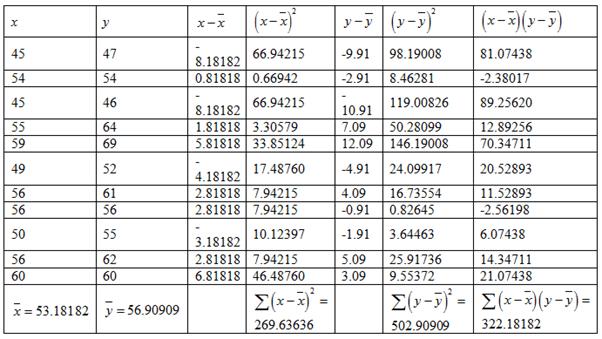
Hence, the standard deviation is given by:
And,
Consider, 
Putting the values in the formula,
Putting the values to obtain
Putting the values to obtain
Hence, the least-square regression line is given by:
Therefore, the least squares regression line for the given data set by removing the outlier is
(f)
>Whether the outlier is influential.
(f)
>Answer to Problem 24E
The outlier is influential.
Explanation of Solution
Given information:
Same as part
Calculation:
From part
From part
From the equations, it can be seen that removing the outlier creates a great difference in the equation of the least square regression line.
Therefore, the outlier is influential.
(g)
>The coefficient of determination for the data set with the outlier removed.
(g)
>Answer to Problem 24E
Coefficient of Determination is
The proportion of variation is more without the outlier.
Explanation of Solution
Given information:
Same as part
Calculation:
From part
The coefficient of determination is given by:
Where
Plugging the values to obtain Coefficient of Determination,
Therefore, the Coefficient of Determination is
Here the coefficient of determination increased without the outlier.
Hence, the proportion of variance explained is more without the outlier.
Want to see more full solutions like this?
Chapter 4 Solutions
Elementary Statistics (Text Only)
- A marketing agency wants to determine whether different advertising platforms generate significantly different levels of customer engagement. The agency measures the average number of daily clicks on ads for three platforms: Social Media, Search Engines, and Email Campaigns. The agency collects data on daily clicks for each platform over a 10-day period and wants to test whether there is a statistically significant difference in the mean number of daily clicks among these platforms. Conduct ANOVA test. You can provide your answer by inserting a text box and the answer must include: also please provide a step by on getting the answers in excel Null hypothesis, Alternative hypothesis, Show answer (output table/summary table), and Conclusion based on the P value.arrow_forwardA company found that the daily sales revenue of its flagship product follows a normal distribution with a mean of $4500 and a standard deviation of $450. The company defines a "high-sales day" that is, any day with sales exceeding $4800. please provide a step by step on how to get the answers Q: What percentage of days can the company expect to have "high-sales days" or sales greater than $4800? Q: What is the sales revenue threshold for the bottom 10% of days? (please note that 10% refers to the probability/area under bell curve towards the lower tail of bell curve) Provide answers in the yellow cellsarrow_forwardBusiness Discussarrow_forward
- The following data represent total ventilation measured in liters of air per minute per square meter of body area for two independent (and randomly chosen) samples. Analyze these data using the appropriate non-parametric hypothesis testarrow_forwardeach column represents before & after measurements on the same individual. Analyze with the appropriate non-parametric hypothesis test for a paired design.arrow_forwardShould you be confident in applying your regression equation to estimate the heart rate of a python at 35°C? Why or why not?arrow_forward
 Big Ideas Math A Bridge To Success Algebra 1: Stu...AlgebraISBN:9781680331141Author:HOUGHTON MIFFLIN HARCOURTPublisher:Houghton Mifflin Harcourt
Big Ideas Math A Bridge To Success Algebra 1: Stu...AlgebraISBN:9781680331141Author:HOUGHTON MIFFLIN HARCOURTPublisher:Houghton Mifflin Harcourt Glencoe Algebra 1, Student Edition, 9780079039897...AlgebraISBN:9780079039897Author:CarterPublisher:McGraw Hill
Glencoe Algebra 1, Student Edition, 9780079039897...AlgebraISBN:9780079039897Author:CarterPublisher:McGraw Hill Holt Mcdougal Larson Pre-algebra: Student Edition...AlgebraISBN:9780547587776Author:HOLT MCDOUGALPublisher:HOLT MCDOUGAL
Holt Mcdougal Larson Pre-algebra: Student Edition...AlgebraISBN:9780547587776Author:HOLT MCDOUGALPublisher:HOLT MCDOUGAL Linear Algebra: A Modern IntroductionAlgebraISBN:9781285463247Author:David PoolePublisher:Cengage Learning
Linear Algebra: A Modern IntroductionAlgebraISBN:9781285463247Author:David PoolePublisher:Cengage Learning



